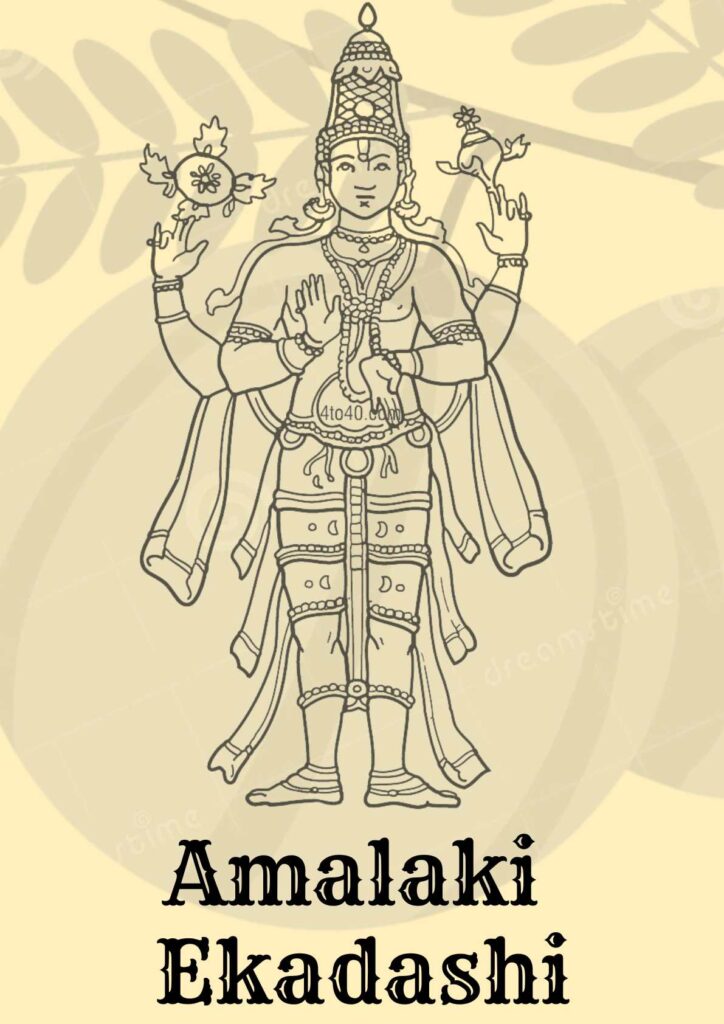
Ekadashi Tithi Begins: at 12:21 AM on Mar 20, 2024
Ekadashi Tithi Ends: at 02:22 AM on Mar 21, 2024
Parana Time – 01:41 PM to 04:07 PM
Note: “Parana” is the breaking of the fast. Ekadashi Parana is observed on the next day of Ekadashi fast after sunrise within Dwadashi Tithi.
On the Krishna Paksha of the Falgun month, the waning moon marks the auspicious occasion of Vijaya Ekadashi. True to its name, observing this Ekadashi fast diligently is believed to bestow victory upon individuals over their adversaries and challengers. Throughout history, numerous kings and rulers have emerged triumphant in fierce battles owing to the influence of this fast. References to the significance of Vijaya Ekadashi fasting can also be found in the Puranas. It is believed that even in dire circumstances, when one finds themselves surrounded by enemies, observing the fast of Vijaya Ekadashi can lead to triumph. Moreover, it is said that observing this fast grant liberation from suffering.
Amalaki Ekadashi Vrat Katha:
In Puranic lore, it is recounted that Lord Shri Hari Vishnu bestowed Lord Brahma with existence by birthing him from his navel, empowering Brahma to undertake the creation of the universe. One auspicious day, driven by a profound desire to unravel the depths of his being and comprehend his existence, Lord Brahma embarked on intense meditation, invoking the name of Parabrahma, Lord Shri Vishnu, with unwavering devotion.
Pleased by Brahma’s profound contemplation and devotion, Lord Vishnu manifested before him. Overwhelmed by the divine presence of Parabrahma, Brahma was moved to tears, which cascaded onto Vishnu’s feet, transforming into an Amla tree. Witnessing this divine phenomenon, Lord Shri Hari Vishnu declared the Amla tree to be cherished and esteemed, decreeing that devotees who venerate this sacred tree on the sacred occasion of Amalaki Ekadashi would be granted salvation and absolution from all sins.
According to Puranic tales, it is recounted that Lord Shri Hari Vishnu birthed Lord Brahma from his navel, bestowing upon him the ability to create the universe. One day, inspired by a deep longing to understand his essence and existence, Lord Brahma immersed himself in profound meditation, fervently invoking the name of Parabrahma, Lord Shri Vishnu. Pleased by Brahma’s devotion, Vishnu appeared before him.
Upon beholding Parabrahma, Brahma was overcome with emotion, tears streaming down his face and falling upon Vishnu’s feet, transforming into an Amla tree. Moved by this display of devotion, Lord Vishnu declared the Amla tree to be sacred to him, decreeing that devotees who worship it on the auspicious day of Amalaki Ekadashi would attain salvation and absolution from sin.
Another tale of Amalaki Ekadashi features King Chitrasena, a devout adherent of Lord Vishnu who faithfully observed the Amalaki Ekadashi fast. Once, while on a hunting expedition with his retinue, they were ambushed and captured by tribal warriors. Intent on sacrificing the king to appease their deity, the tribals prepared for the ritual. As the king lost consciousness and collapsed, a divine radiance emanated from his body, vanquishing the tribal assailants.
Upon regaining consciousness, King Chitrasena learned that he had been spared by the grace of his unwavering observance of the Amalaki Ekadashi fast, thus reaping its virtues and blessings.
Amalaki Ekadashi Rituals
To worship Lord Vishnu on Amalaki Ekadashi and receive his blessings, follow these rituals:
1. Wake up early before sunrise and take a bath with pure water.
2. Begin your fast dedicated to Lord Vishnu.
3. Worship Lord Vishnu and the Amla tree, placing a Kalash containing Navaratna under the gooseberry tree.
4. Light incense and perform the Amla Ekadashi Aarti.
5. After the Aarti, offer food to a hungry person or a Brahmin.
6. Donate clothes and Amla (Gooseberry) to those in need.
7. Enhance the spiritual ambiance with aromatic incense sticks.
Remember, while observing Amalaki Ekadashi, there are certain practices to avoid. Let’s explore what they are.
Here are some practices to refrain from on Amalaki Ekadashi: